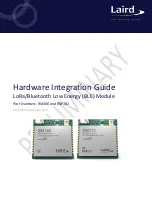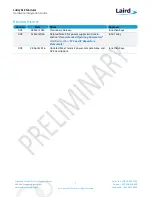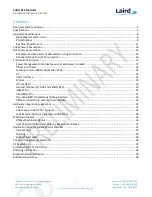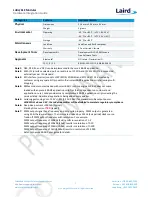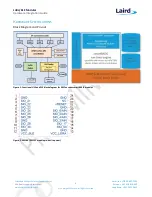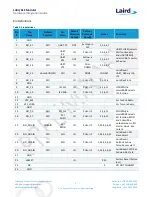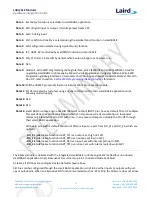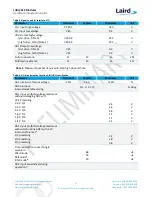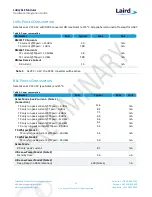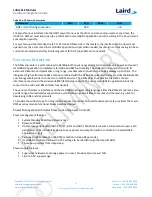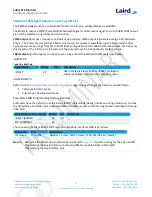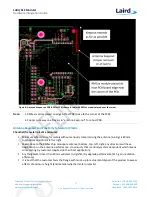
LoRa/BLE Modules
Hardware Integration Guide
Embedded Wireless Solutions Support Center:
http://ews-support.lairdtech.com
www.lairdtech.com/wireless
10
© Copyright 2016 Laird. All Rights Reserved
Americas: +1-800-492-2320
Europe: +44-1628-858-940
Hong Kong: +852 2923 0610
Note 1: Secondary function is selectable in smartBASIC application.
Note 2: DIO = Digital Input or Output. I/O voltage level tracks VCC.
Note 3: AIN = Analog Input
Note 4: DIO or AIN functionality is selected using the GpioSetFunc() function in smartBASIC.
Note 5: AIN configuration selected using GpioSetFunc() function.
Note 6: I2C, UART, SPI controlled by xxxOPEN() functions in smart BASIC.
Note 7: SIO_21 to SIO_24 are DIO by default when $autorun$ app runs on power up.
Note 8: N/A
Note 9: Hidden 2-Wire SWD Programming/Debug Interface, pin22 (SWDIO) and pin23 (SWDCLK). Used for
upgrading smartBASIC runtime engine FW with J-link programmer. Using this hidden 2-Wire SWD
Programming/Debug Interface on customers host PCB requires header connector Samtec FTSH-105-
01-L-DV, refer to section
2-Wire SWD Programming/Debug Interface
Note 10: Pull the nRESET pin (pin 22) low for minimum 100 mS to reset the module.
Note11: SPI CS is created by customer using any spare SIO pin within their smartBASIC application script
allowing multi-dropping.
Note12: N/A
Note13: N/A
Note14: smart BASIC runtime engine has DIO (Default Function) INPUT pins, have by default PULL-UP enabled.
This was done to avoid floating inputs (which can also cause current consumption in low power
modes (e.g. StandbyDoze) to drift with time. In any case customer can disable the PUL-UP through
their smart BASIC application.
All the SIO pins (with a default function of DIO are inputs – apart from SIO_21 and SIO_23, which are
outputs):
- SIO_21 (alternative function UART_TX) is an output, set high (in FW).
- SIO_23 (alternative function UART_RTS) is an output, set low (in FW).
- SIO_22 (alternative function UART_RX) is an input, set with internal pull-up (in FW).
- SIO_24 (alternative function UART_CTS) is an input, set with internal pull-down (in FW).
The RM1xx module is delivered with the integrated smartBASIC runtime engine FW loaded (but no onboard
smartBASIC application script). Because of this, it starts up in AT command mode by default.
At reset, all SIO lines are configured as the defaults shown above.
SIO lines can be configured through the smart
BASIC application script to be either inputs or outputs with pull-
ups or pull-downs. When an alternative SIO function is selected (such as I2C or SPI), the firmware does not allow

